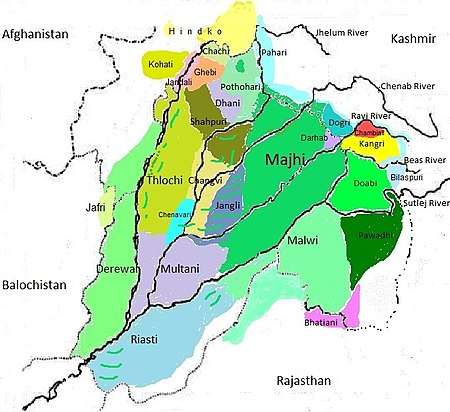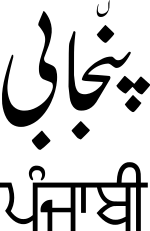Doabi dialect
Doabi is a dialect of the Punjabi language. The dialect is named for the region in which it was historically spoken, Doaba[2] (also known as Bist Doab); the word doab means "the land between two rivers" and this dialect was historically spoken in the doab between the Beas River and Sutlej River. Its occurrence in parts of Pakistani Punjab owes to post-1947 migration of Muslim populace from East Punjab. The region it is now spoken includes: the Jalandhar, Hoshiarpur, Kapurthala and Nawanshahr districts of Indian Punjab, including the areas known as the Dona and Manjki; and the Toba Tek Singh and Faisalabad districts of Pakistani Punjab.
| Doabi Punjabi | |
|---|---|
| Native to | Doaba, Indian Punjab and Pakistani Punjab |
| Region | Punjab |
Indo-European
| |
| Language codes | |
| ISO 639-3 | – |
| Glottolog | doab1238[1] |
 Dialects of the Punjabi language. Doabi is in lime green to the right of Majhi | |
The sub dialects of Doabi include Dona and Manjki.[3]
| Part of a series on the |
| Punjabis |
|---|
 |
|
|
Asia
Europe North America |
|
Culture |
|
Punjab portal |
Analysis
The Doabi dialect in its eastern part blends with the Malwai dialect of Ludhiana district, and in its Northern side, it shares the linguistic features of Pahari. Some of the linguistic Linguistic features of the Doabi dialect that separate it from other Punjabi dialects are as below:[4]
Consonants
| Consonant | Doabi word | English translation |
|---|---|---|
| p ⟨ਪ⟩ | /pəl/ | ‘moment’ (ਪਲ) |
| pʰ ⟨ਫ⟩ | /pʰəl/ | ‘fruit’ (ਫਲ) |
| b ⟨ਬ⟩ | /baːlɳ/ | ‘firewood’(ਬਾਲਣ) |
| t̪ ⟨ਤ⟩ | /taːɾ/ | ‘wire’ (ਤਾਰ) |
| t̪ʰ ⟨ਥ⟩ | /tʰaːl/ | ‘round tray’(ਥਾਲ) |
| d̪ ⟨ਦ⟩ | /daːl/ | ‘pulse’ |
| ʈ ⟨ਟ⟩ | /ʈaːl/ | ‘pile’ |
| ʈʰ ⟨ਠ⟩ | /ʈʰiːk/ | ‘correct’ (ਠੀਕ) |
| ɖ ⟨ਡ⟩ | /ɖaːk/ | ‘mail’ (ਡਾਕ) |
| t͡ʃʰ ⟨ਛ⟩ | /t͡ʃʰəp/ | ‘imprint’ (ਛਾਪ) |
| d͡ʒ ⟨ਜ⟩ | /dʒoːk/ | leech (ਜੋਕ) |
| k ⟨ਕ⟩ | /kaːɡ/ | ‘crow’ (ਕਾਂ) |
| kʰ ⟨ਖ⟩ | /kʰoːl/ | ‘open’ |
| ɡ ⟨ਗ⟩ | /ɡaːɭ/ | ‘abuse’ (ਗਾਲ) |
| m ⟨ਮ⟩ | /moːɾ/ | ‘peacock’ |
| n ⟨ਨ⟩ | /nəɾ/ | ‘male’ |
| ɳ* ⟨ਣ⟩ | /ɦoɳ/ | ‘now’ (ਹੁਣ) |
| l ⟨ਲ⟩ | /laːl/ | ‘red’ (ਲਾਲ) |
| ɭ* ⟨ਲ਼⟩ | /koːɭ/ | ‘near’ (ਕੋਲ਼) |
| (s ⟨ਸ⟩) | /soɳ/ | ‘hear’ (ਸੁਣ) |
| (ʃ ⟨ਸ਼⟩) | /ʃeːɾ/ | ‘lion’ (ਸ਼ੇਰ) |
| (z ⟨ਜ਼⟩) | /zoːɾ/ | ‘strength’ (ਜ਼ੋਰ) |
| (f ⟨ਫ਼⟩) | /fəslə/ | ‘distance’ |
| ɦ ⟨ਹ⟩ | /ɦoːɾ/ | ‘more’ (ਹੋਰ) |
| ɾ ⟨ਰ⟩ | /ɾoːɡ/ | ‘disease’ |
| ɽ* ⟨ੜ⟩ | /pɪɽ/ | ‘pain’ (ਪੀੜ) |
* does not occur word initially
Vowels
Doabi has ten vowels. These are /ə, ɪ, ʊ, aː, ɛː, eː, iː, ɔː, oː, uː/
For example:
| Vowel | Word | Translation |
|---|---|---|
| ə ਅ | /əkkʰ/ | 'eye' |
| ʊ ਉ | /ʊʈʰ/ | ‘awake’ |
| ɪ ਇ | /ɪʈʈ/ | ‘brick’ |
| aː ਆ | /aːs/ | ‘hope’ |
| ɛː ਐ | /ɛːnək/ | spectacles’ |
| uː ਊ | /uːʈʈʰ/ | ‘camel’ |
| eː ਏ | /ʃeːɾ/ | ‘lion’ |
| oː ਅੋ | /moːɾ/ | ‘peacock’ |
| ɔː ਔ | /ɦɔːl/ | ‘fear’ |
| iː ਈ | /tiːɾ/ | ‘arrow’ |
Other suprasegmental phonemes
Tone, stress and nasalization in Doabi are phonemic.
Tone
Three tones are used in Doabi; low, mid and high. For example;
| Tone | Doabi word | English translation |
|---|---|---|
| Falling | ਭਾ pà | ‘rate’ |
| Neutral | ਪਾ pa | ‘put’ |
| Rising | ਪਾਹ pá | ‘harsh’ |
Stress
Stress in Doabi is realized in two ways, syntagmatically and paradigmatically.
Syntagmatically, stress-shift results in change of meaning. This kind of stress is often orthographically unmarked, and may shift any tone present in a word to the stressed syllable.
For example:
| Doabi word | English translation |
|---|---|
| ਘੜਾ /'kə̀ɽa:/ | ‘pitcher’ |
| ਘੜਾ /kə'ɽà:/ | ‘to shape, sculpt, mold’ |
Paradigmatically, Doabi has stressed and unstressed syllables;
| Unstressed | Doabi word | English translation |
|---|---|---|
| s | satt | ‘essence’ |
| t | pata | ‘address’ |
| Stressed | Doabi word | English translation |
|---|---|---|
| s | sat | ‘seven’ |
| tt | patta | ‘leaf’ |
Some basic vocabulary items
| Doabi pronunciation | English translation |
|---|---|
| pāpā | ‘father’ |
| pɛ̀n | ‘sister’ |
| bhrā | ‘brother’ |
| se/seb | ‘apple’ |
| chònnā | ‘paddy’ |
| vaddā | ‘elder’ |
Features
Substituting letters
Doabi's drop the letter "v" at the start of a word and use the letter "b"[5] as in "Vada" (big) to "Bada". They also use the letter "o" elsewhere in a word instead of a "v" as in "Khvab" (dream) to "Khoaab". A distinctive feature of Doabi is the use of the "w" sound. Where "v" appears in the middle of a word in standard Punjabi, Doabis use "w" so that "hava" (wind) becomes "hawa". Also, the vowel "u" is pronounced with an "o". Accordingly, "khush" (happy) becomes "khosh" or "kuht" (to beat) becomes "koht". In Doabi, any word beginning with "i" is pronounced with "e". For example, the word "khich" (to pull) is pronounced as "khech" or the word "vich" (inside) is pronounced as "bech".
Doabis do not use "z" and therefore substitute "j". This is common in the Punjabi language as "z" is not indigenous to the area.
Sentence structure
Doabi's end sentences with "aa" (present tense) and "sigey" (past —tense), instead of "han" (present tense) and "san" or "si" (past tense). "Aiddan", "Jiddan", "Kiddan" are all commonly used adverbs in Doabi as opposed to the ”Inj / Aistaran", "Jistaran", Kistaran" used in Punjabi's prestige dialect, Majhi.
Present Tense: Usage of aa (sing.) and aa (plu.)
Examples:
| Phrase | Doabi | Standard Punjabi |
| He is doing | Oh kardā ā
ਉਹ ਕਰਦਾ ਆ اوہ کرداا |
Oh kardā ɛ̀/e*
ਉਹ ਕਰਦਾ ਹੈ/ਏ* اوہ کردا ہے/اے |
| They are doing | Oh karde (y)ā
ਉਹ ਕਰਦੇ ਆ اوہ کردے آ |
Oh karde han
ਉਹ ਕਰਦੇ ਹਨ اوہ کردے ہِن |
| *spoken forms |
Past Tense: Uninflected sī, or number- and gender-inflected sīgā/sīgī/sīge/sīgīā, in Doabi
Examples:
| Phrase | Doabi | Standard Punjabi |
| He was doing | oh kardā sī/sīgā
ਉਹ ਕਰਦਾ ਸੀ/ਸੀਗਾ اوہ کردا سی/سیگا |
oh kardā sī
ਉਹ ਕਰਦਾ ਸੀ اوہ کردا سی |
| They were doing | oh karde sī/sīge
ਉਹ ਕਰਦੇ ਸੀ /ਸੀਗੇ اوہ کردے سی/سیگے |
oh karde san
ਉਹ ਕਰਦੇ ਸਨ (also ਸਣ in spoken Majhi) اوہ کردے سن |
| You (sing. m.) were doing | tũ kardā sī/sīgā
ਤੂੰ ਕਰਦਾ ਸੀ/ਸੀਗਾ توں کردا سی/سیگا |
tũ kardā sɛ̃
ਤੂੰ ਕਰਦਾ ਸੈਂ توں کردا سیں |
| You (pl.) were doing | tusī̃ karde sī/sīge
ਤੁਸੀਂ ਕਰਦੇ ਸੀ/ਸੀਗੇ تسی کردے سی/سیگے |
tusī̃ karde so
ਤੁਸੀਂ ਕਰਦੇ ਸੋ تسی کردے سو |
| I (m.) was doing | mɛ̃ kardā sī/sīgā
ਮੈਂ ਕਰਦਾ ਸੀ/ਸੀਗਾ میں کردا سی/سیگا |
mɛ̃ kardā sã
ਮੈਂ ਕਰਦਾ ਸਾਂ میں کردا ساں |
| We were doing | āppā karde sī/sīge
ਆਪਾਂ ਕਰਦੇ ਸੀ/ਸੀਗੇ آپاں کردے سی/سیگے |
asī̃ karde sã
ਅਸੀਂ ਕਰਦੇ ਸਾਂ اسیں کردےساں |
Vocabulary
| Doabi | English | Standard Punjabi |
|---|---|---|
| "hougā" | Will Happen | "hovegā" |
| "bāɽa" | Cow shed | "havelī" |
| "dhauṇ" | Neck | "gardan" |
| "pāḷā or ṭhanḍā" | Cold weather | "sardī" |
| "kunjī" | Key | "chābbī" |
| "gaṭhe" | Onions | "ganḍeh" |
| "niāṇe" | Children | "bacche" |
| "dekhnā" | To See | "vekhnā" |
| "kardā hɛgā / kardā sī” | To Be Doing | "kar riha ɛ̀" |
| "gábbe" | Middle | "vichkār" |
| "līre/kappaṛe/talle" | Clothes | "kappare" |
| "lītā" | Bought | "kharīdā" |
See also
- Languages of Pakistan
- Languages of India
- List of Indian languages by total speakers
- Malwi dialect
- Puadhi language
References
- Hammarström, Harald; Forkel, Robert; Haspelmath, Martin, eds. (2017). "Doab". Glottolog 3.0. Jena, Germany: Max Planck Institute for the Science of Human History.
- Punjabi University, Patiala.
- Tribune 28 January 2009 Sarbjit Dhaliwal
- "Archived copy". Archived from the original on 2016-06-03. Retrieved 2014-04-03.CS1 maint: archived copy as title (link)
- "Archived copy". Archived from the original on 2016-03-04. Retrieved 2014-11-26.CS1 maint: archived copy as title (link)